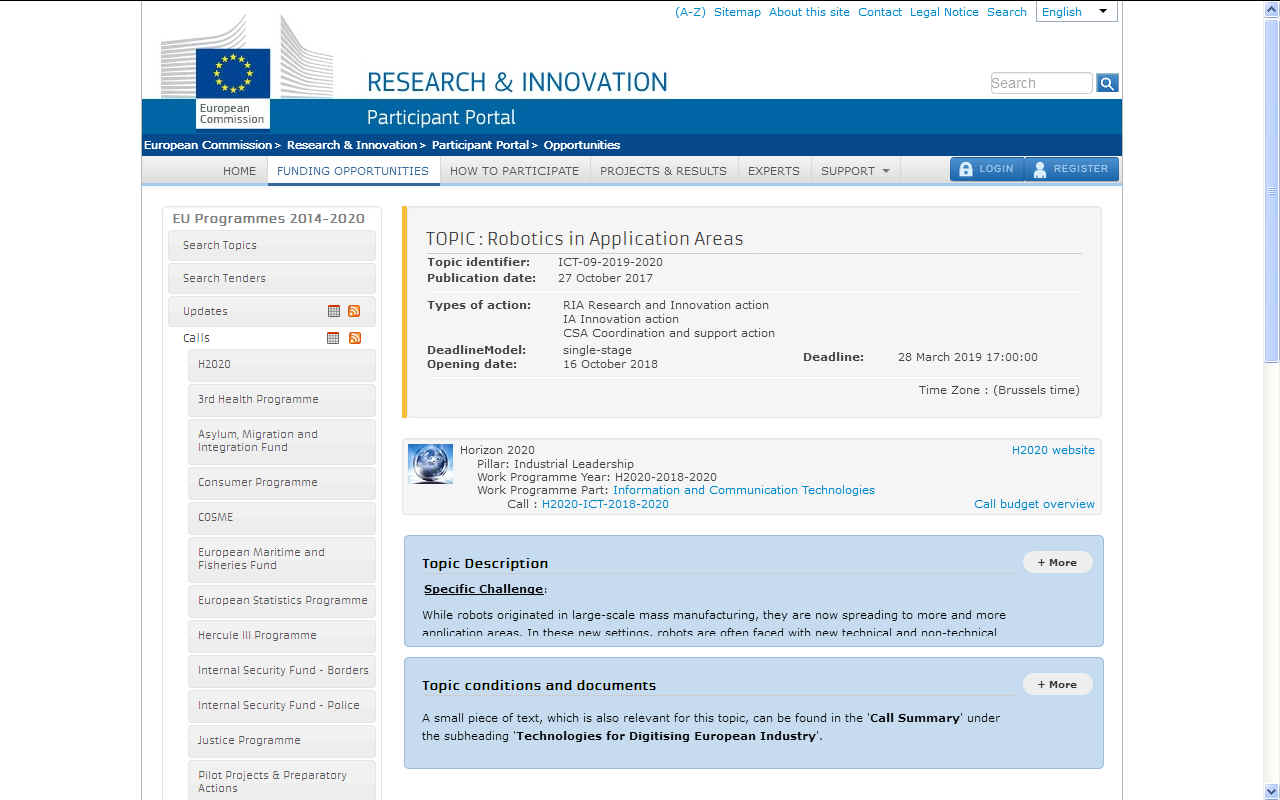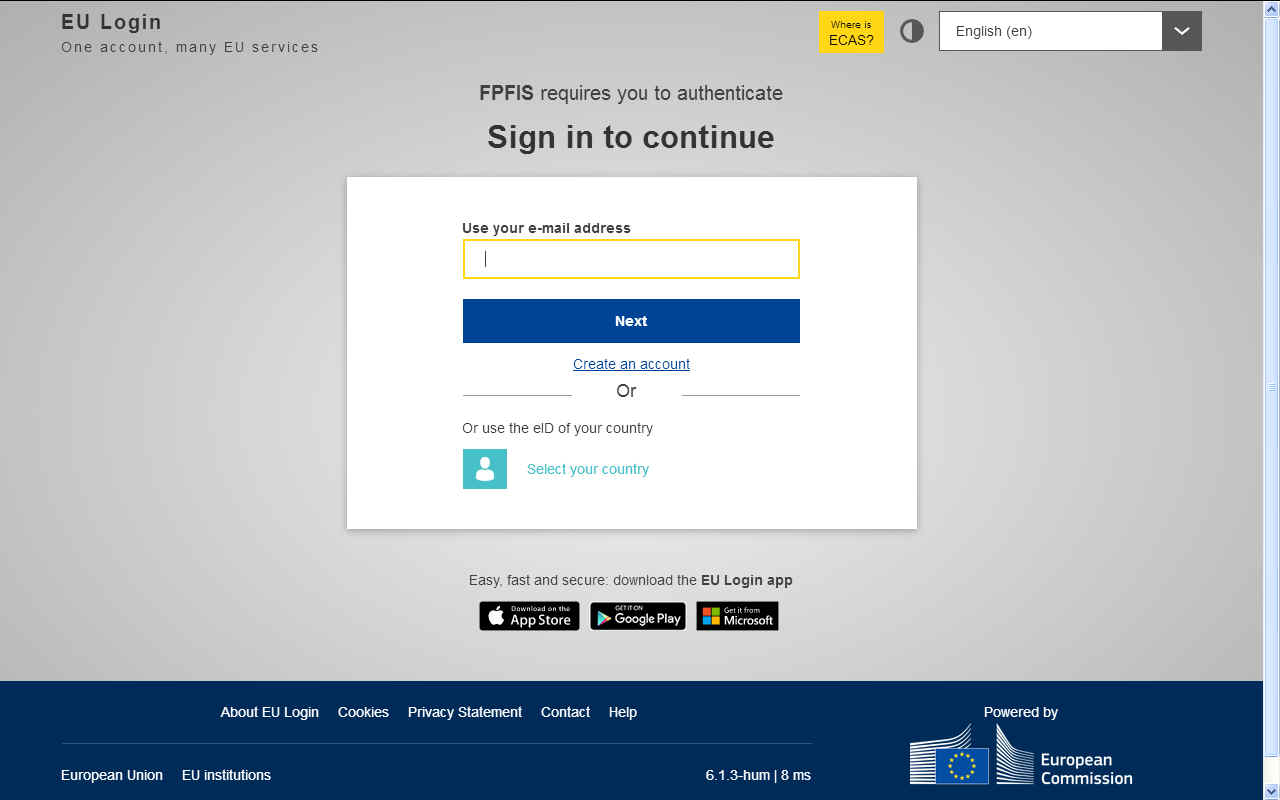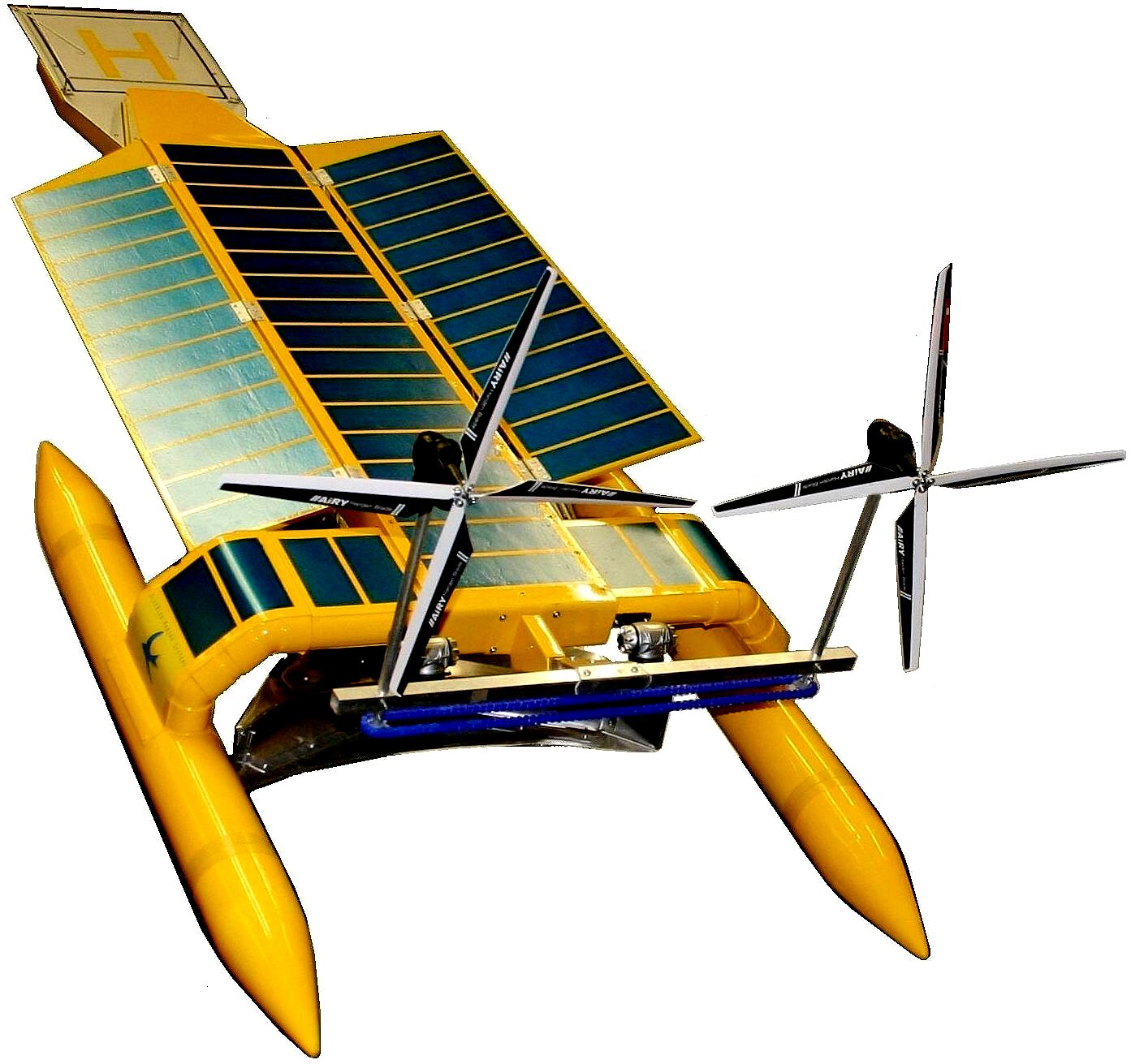|
H2020
RESEARCH INNOVATION
ACTION
ABOUT -
CONTACTS - DONATE
- FOUNDATION -
HOME - A-Z INDEX

ICT-09-2019-2020: Robotics in Application Areas
Topic Description
- Specific Challenge:
While robots originated in large-scale mass manufacturing, they are now spreading to more and more application areas. In these new settings, robots are often faced with new technical and non-technical challenges. The purpose of this topic is to address such issues in a modular and open way, and reduce the barriers that prevent a more widespread adoption of
robots. Four Priority Areas (PAs) are targeted: healthcare, inspection and maintenance of infrastructure, agri-food, and agile production.
User needs, ethical, legal, societal and economic aspects should be addressed in order to raise awareness and take-up by citizens and businesses. Privacy and cybersecurity issues, including security by design and data integrity should also be addressed, where appropriate.
SCOPE:
a)
Research and Innovation boosting promising robotics
applications
Innovative approaches to hard research problems in relation to applications of
robotics in promising new areas are particularly encouraged. Proposals are expected to enable substantially improved solutions to challenging technical issues, with a view of take-up in applications with high socio-economic impact. Driven by application needs, the work can start from research at low TRL, but proposals are expected to validate their results in realistic environments in order to demonstrate the potential for take-up in the selected application(s).
The call is open to all robotics-related research topics and to all new application areas. Excluded are the four priority areas which are already covered elsewhere in this work programme: healthcare, inspection and maintenance of infrastructure, agri-food and agile production. Proposals will be expected to plan efforts to connect and cooperate with the DIHs, Platforms and other relevant activities of this work programme, as appropriate.
The Commission considers that proposals requesting a contribution from the EU between €3 million and €5 million would allow this area to be addressed appropriately. Nonetheless, this does not preclude submission and selection of proposals requesting other amounts.
b) Innovation Actions - Robotics for infrastructure inspection and maintenance
Establish large-scale pilots capable of demonstrating the use of robotics at scale in actual or highly realistic operating environments; showcase advanced prototype applications built around platforms operating in real or near-real environments and demonstrate high levels of socio-economic impact.
Through large-scale pilots, proposals are expected to make a significant step forward in platform development in the area of infrastructure inspection and maintenance. Starting from suitable reference architectures, platform interfaces are defined, tested via piloting, and supported via ecosystem building preparing their roll-out, and are being evolved over time into standards.
Each proposal is expected to establish large scale pilots. They are expected to: consider utilising existing infrastructure and links to other European, national or private funding-sources; identify the long-term sustainability of the pilot; develop scalable technical solutions capable of meeting performance targets; develop metrics and performance measures for the pilot; engage relevant industry stakeholders, including SMEs, in the provision and operation of the pilot. Proposals will be expected to dedicate resources to disseminate best practice and coordinate access to platforms and demonstrators, in particular in connecting with the Robotics DIHs and Core Technologies actions and other relevant activities, in H2020 and beyond.
Pilots are expected to address both technical and non-technical issues, such as socio-economic impact, novel business models, legal and regulatory, ethical and cyber-security issues and connections to Big Data and IoT.
The Commission considers that proposals requesting a contribution from the EU between €7 million and €9 million would allow this area to be addressed appropriately. Nonetheless, this does not preclude submission and selection of proposals requesting other amounts.
c) Robotics Competitions
Competitions aims at reducing technical and commercial risks by allowing commercial and technical performance data to be gathered and assessed. They provide a real or near-real operating environment for long-term trials and the testing of deployment strategies.
Proposals (CSA) should address the delivery of challenge-led, robotics competitions focusing on the four application areas prioritised: Healthcare, Infrastructure Inspection and Maintenance, Agri-Food, and Agile Production. Besides the technological objectives, proposals are also expected to stimulate public engagement and engage with the Robotics DIHs. Proposals should address all aspects of running competitions as public events, and engage with the media and public. Proposals should seek to mobilise external partners in sponsoring and setting up the competitions.
Expected Impact:
a) - Strengthening European excellence in Robotics S&T
Boosting the use of robotics in promising application areas
Opening up new markets for robotics
Lowering barriers in the deployment of robotics-based solutions.
b) - Demonstration of the potential for robotics to impact at scale in the chosen application areas prioritised in this call (infrastructure inspection and maintenance).
Reduction of technical and commercial risk in the deployment of services based on robotic actors within the selected application area.
Greater understanding from the application stakeholders of the potential for deploying robotics.
Demonstration of platforms operating over extended time periods in near realistic environments and promotion of their use.
Develop the eco-system around the prioritised application areas to stimulate deployment.
Contribution to the development of open, industry-led or de facto standards
c) - Greater public exposure to actual robotics capability.
Greater engagement with competitions from commercial organisations in the four prioritised application areas: Healthcare, Infrastructure Inspection and Maintenance, Agri-Food and Agile Production.
Delegation Exception Footnote: It is expected that this topic will continue in 2020.

TOPIC
CONDITIONS AND DOCUMENTS
A small piece of text, which is also relevant for this topic, can be found in the 'Call Summary' under the subheading 'Technologies for Digitising European Industry'.
1. Eligible countries: described in Annex A of the Work Programme.
A number of non-EU/non-Associated Countries that are not automatically eligible for funding have made specific provisions for making funding available for their participants in Horizon 2020 projects. See the information in the Online Manual.
2. Eligibility and admissibility conditions: described in Annex B and Annex C of the Work Programme.
Proposal page limits and layout: please refer to Part B of the proposal template in the submission system below.
3. Evaluation:
Evaluation criteria, scoring and thresholds are described in Annex H of the Work Programme.
Submission and evaluation processes are described in the Online Manual.
4. Indicative time for evaluation and grant agreements:
Information on the outcome of evaluation (single-stage call): maximum 5 months from the deadline for submission.
Signature of grant agreements: maximum 8 months from the deadline for submission.
5. Proposal templates, evaluation forms and model grant agreements (MGA):
Research and Innovation Action:
Specific provisions and funding rates
Standard proposal template
Standard evaluation form
General MGA - Multi-Beneficiary
Annotated Grant Agreement
Innovation Action:
Specific provisions and funding rates
Standard proposal template
Standard evaluation form
General MGA - Multi-Beneficiary
Annotated Grant Agreement
Coordination and Support Action:
Specific provisions and funding rates
Standard proposal template
Standard evaluation form
General MGA - Multi-Beneficiary
Annotated Grant Agreement
6. Additional provisions:
Horizon 2020 budget flexibility
Classified information
Technology readiness levels (TRL) – where a topic description refers to TRL, these definitions apply
Members of consortium are required to conclude a consortium agreement, in principle prior to the signature of the grant agreement.
8. Additional documents:
1. Introduction WP 2018-20
5. Introduction to Leadership in enabling and industrial technologies (LEITs) WP 2018-20
5i. Information and communication technologies (ICT) WP 2018-20
18. Dissemination, Exploitation and Evaluation WP 2018-20
General annexes to the Work Programme 2018-2020
Legal basis: Horizon 2020 Regulation of Establishment
Legal basis: Horizon 2020 Rules for Participation
Legal basis: Horizon 2020 Specific Programme
7. Open access must be granted to all scientific publications resulting from Horizon 2020 actions.
Where relevant, proposals should also provide information on how the participants will manage the research data generated and/or collected during the project, such as details on what types of data the project will generate, whether and how this data will be exploited or made accessible for verification and re-use, and how it will be curated and preserved.
Open access to research data
The Open Research Data Pilot has been extended to cover all Horizon 2020 topics for which the submission is opened on 26 July 2016 or later. Projects funded under this topic will therefore by default provide open access to the research data they generate, except if they decide to opt-out under the conditions described in Annex L of the Work Programme. Projects can opt-out at any stage, that is both before and after the grant signature.
Note that the evaluation phase proposals will not be evaluated more favourably because they plan to open or share their data, and will not be penalised for opting out.
Open research data sharing applies to the data needed to validate the results presented in scientific publications. Additionally, projects can choose to make other data available open access and need to describe their approach in a Data Management Plan.
Projects need to create a Data Management Plan (DMP), except if they opt-out of making their research data open access. A first version of the DMP must be provided as an early deliverable within six months of the project and should be updated during the project as appropriate. The Commission already provides guidance documents, including a template for DMPs. See the Online Manual.
Eligibility of costs: costs related to data management and data sharing are eligible for reimbursement during the project duration.
The legal requirements for projects participating in this pilot are in the article 29.3 of the Model Grant Agreement.
BUDGET:
ICT-09-2019-2020 - IA Innovation action EUR 28,000,000 single-stage 16 October 2018
- 28 March 2019

ROBOTIC
OCEAN
CONDITIONER - This vessel is designed to operate in fleets
to target ocean waste before it settles on the ocean floor
where economic recovery is difficult. There is nothing like it in
existence today, but with the proper incentives and
collaboration it could become a major contributor toward food
security from blue
growth. Robotics and satellites are essential elements of
this potential technological solution to ocean pollution.

ROBOT
CONFERENCE - Collaborati
.....
LINKS
& REFERENCE
https://webgate.ec.europa.eu/cas/login
http://ec.europa.eu/research/participants/portal/desktop/en/opportunities/h2020/topics/ict-09-2019-2020.html
This
website is provided on a free basis as a public information
service. Copyright © Cleaner
Oceans Foundation Ltd (COFL) (Company No: 4674774)
2018. Solar
Studios, BN271RF, United Kingdom.
COFL
is a charity without share capital. The names Amphimax™
RiverVax™
and SeaVax™
are trademarks.
|


